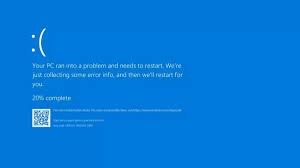Microsoft is finally getting rid of the Windows Blue Screen of Death: Here’s why

For decades, the dreaded Blue Screen of Death (BSOD) has been an unsettling symbol for every Windows user. Whether you were gaming, working, or just browsing the web, a sudden crash into a blue abyss meant lost data, frustration, and cryptic error codes. But Microsoft is finally saying goodbye to this iconic error screen — and not just for cosmetic reasons.
With the rollout of Windows 11 24H2, Microsoft is officially replacing the BSOD with a new version: a Black Screen of Death (or Green for Insider Preview builds). This shift may seem superficial at first glance, but there’s a deeper story behind it — one involving user experience, system recovery, and a global IT crisis that prompted a reevaluation of failure responses.
A Legacy of Crashes: What Was the Blue Screen of Death?
The Blue Screen of Death dates back to Windows 3.0, introduced in 1990. It appears when the Windows operating system encounters a critical error it cannot recover from — usually due to driver issues, memory failures, or corrupted system files. The original BSOD was a screen filled with raw hexadecimal data that only engineers could understand. Over time, Microsoft simplified it by adding a sad face emoji, a brief error message, and a QR code.
Yet, no matter how Microsoft dressed it up, the BSOD always symbolized failure — and often frustration. Its sudden appearance interrupted productivity, forced restarts, and in many cases, left users clueless about what went wrong.
The Final Trigger: CrowdStrike’s Catastrophic Crash
The tipping point came in July 2024, when a faulty update from cybersecurity firm CrowdStrike caused widespread system crashes around the globe. Over 8 million Windows devices were affected, many of which displayed the BSOD. From airlines and hospitals to banks and newsrooms, organizations were paralyzed for hours.
The incident wasn’t Microsoft’s direct fault, but it did expose a painful truth: the traditional BSOD failed to offer users a helpful or reassuring response during system failures. The outdated design and technical jargon added confusion during already stressful moments.
In response, Microsoft launched the Windows Resiliency Initiative, an effort to modernize error handling, reduce downtime, and shift the narrative around system failure. The BSOD’s replacement is just one visible sign of this initiative.
What’s New: The Black Screen of Death
So, what has changed?
The new Black Screen of Death (BlackSOD) brings a cleaner, minimalist look. The iconic blue background is gone, replaced by a sleek black interface that matches the dark theme of Windows 11. The sad face emoji and QR code have been removed. Now, users are presented with a brief message:
“Your device ran into a problem and needs to restart,”
along with a stop code and sometimes the name of the faulty driver.
Behind the scenes, the changes are even more significant. The new crash handling interface works in tandem with a tool called Quick Machine Recovery, introduced in Windows 11. This feature allows many PCs to restart in as little as two seconds after a critical failure — a major improvement over previous reboot times.
Why Microsoft Made the Switch
There are three key reasons why Microsoft is finally killing off the traditional Blue Screen:
1. Reduce User Anxiety
Microsoft’s UX research showed that the blue screen triggered anxiety and confusion, especially for non-technical users. The bright color and vague message created the impression of a major catastrophe, even when the issue was recoverable. The black version feels more modern and less alarming — a psychological nudge toward calmness.
2. Modernize the OS Aesthetic
Windows 11 emphasizes minimalism and continuity across all interfaces. The bright blue BSOD clashed visually with the rest of the system’s sleek, dark-themed design. The black screen offers visual consistency and feels more aligned with modern error screens seen on consoles or mobile devices.
3. Improve IT Response
With widespread use in enterprise environments, Microsoft wanted the crash screen to be more functional. Removing distractions like the emoji and QR code allows IT professionals to focus on the essentials: the stop code and the error log. Future updates may even allow users to send crash data directly to administrators with a single click.
Public Response: Mixed Feelings
On Reddit, Twitter, and tech forums, reactions to the change have been mixed.
Some users welcome the update:
“It’s about time. That blue screen felt like a relic from the ’90s.”
Others are nostalgic:
“RIP sad face emoji. You got me through a lot of rough reboots.”
Many IT pros appreciate the streamlined design but hope for even deeper diagnostic tools in future updates.
Regardless of opinions, one thing is clear: Microsoft’s decision marks the end of an era.
What’s Next?
The Black Screen of Death is rolling out in the Windows 11 24H2 update, which is expected to become broadly available by late summer 2025. Insider Preview users are already seeing the green variant of the new error screen, while enterprise partners are receiving documentation on how to interpret new crash messages.
In the future, Microsoft plans to integrate cloud-based diagnostics, allowing the OS to upload crash logs and suggest recovery steps in real time. Eventually, the goal is to eliminate system halts altogether by improving driver validation and using predictive analytics to prevent crashes before they happen.
Final Thoughts
The retirement of the Blue Screen of Death isn’t just a branding decision — it’s a symbol of Microsoft’s evolving relationship with its users. As operating systems become smarter, faster, and more user-friendly, even the way they fail is changing.
While we may miss the quirky, sad-face crashes of old, the move toward a more refined, less disruptive experience is ultimately a win for users — whether you’re a casual user or a sysadmin managing thousands of machines.
After 30+ years, the Blue Screen of Death is finally laid to rest. And in its place rises a better, smarter, and less terrifying way to crash.






